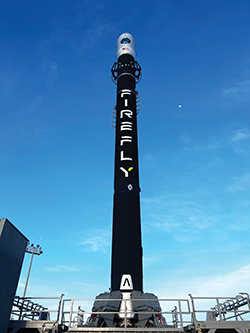Firefly Poised To Test Launch-On-Demand Service For U.S. Space Force

Firefly’s Alpha rocket reached orbit on its second flight in October 2022.
Sometime in the next six months, Boeing’s Millennium Space Systems and startup Firefly Aerospace will receive a call from the U.S. Space Force to integrate and launch a satellite in 24 hr.
Until then, the companies will stand at the ready for the military’s Victus Nox mission, a rapid-response demonstration sponsored by the Space Systems Command’s (SSC) Space Safari Program Office.
- Victus Nox to fly on third Alpha mission
- Boeing’s Millennium Space to provide satellite
The companies began their vigil on Aug. 30, the opening of a period of readiness known as “hot standby” that could last until March.
There are two windows within the hot standby, Firefly’s Chief Technology Officer Shea Ferring told Aviation Week on the sidelines of the 2023 Small Satellite Conference in Logan, Utah. “The first one is spacecraft-centric, and that’s when [satellite manufacturer] Millennium gets the call where they have to deliver the spacecraft to the launch site, load propellant and then put it in a ready state.”
Millennium, which built the spacecraft, will have 60 hr. to transport the payload to Vandenberg SFB, California, fuel it and install a payload adapter for Firefly’s Alpha launch vehicle.
“Then we’re at hold again until we get the 24-hr. notice to launch,” Ferring said. “At that point, we’re told: ‘Here’s your trajectory—go.’”
The Firefly team would then update the launcher’s trajectory and guidance software, encapsulate the payload, transport it to the pad, install it on top of the Alpha rocket and attempt to launch at the first available window.
Once the satellite reaches orbit, Millennium has 48 hr. to prepare it for a space domain awareness mission, details of which were not disclosed. “The basic scenario is: ‘How do you respond quickly to something?’” Ferring explained.
Firefly is prepared to launch the spacecraft into sun-synchronous, polar, midinclination or any other orbit accessible from Vandenberg. “They gave us some [reference trajectories] to work with, but we don’t know [where it’s going],” he added.
In preparation, Firefly has conducted fueling demonstrations and a static test firing of the rocket at the launchpad. It also has used a test payload to practice fueling, encapsulating and installation onto the rocket at the launchpad in less than 12 hr. “It’s been almost like a sporting team preparing for the big game,” says Trina Patterson, Firefly’s vice president of marketing and communications.

Victus Nox is for demonstration purposes only, and the spacecraft will not be used to examine any specific threat, the SSC said. It has previously also declined to disclose the capabilities of the satellite.
For the program, Millennium pulled a satellite bus from its production line, modified it and delivered it about eight months after being awarded the program. The Victus Nox satellite, which had completed environmental testing when Aviation Week viewed it in April, is about the size of a mini fridge. Millennium declined to say upon which satellite bus it is based.
Space domain awareness has become a priority for the U.S. Space Force as it seeks to understand what adversaries, especially China and Russia, are doing in space. This satellite monitoring method attempts to shorten response times to new threats in orbit by improving its rapid launch capabilities, like those that are part of Victus Nox.
The mission will mark the third flight of Firefly’s Alpha rocket, a two-stage, liquid-oxygen- and kerosene-fueled booster designed to carry up to 2,580 lb. to low Earth orbit or nearly 1,642 lb. to sun-synchronous orbit—more than three times the lift capacity of Rocket Lab’s Electron.
The company recovered from Alpha’s unsuccessful September 2021 debut with a second mission in October 2022 that reached orbit, albeit lower than intended.
Cedar Park, Texas-based Firefly was awarded the Victus Nox Tactically Responsive Space mission 11 months ago under an Orbital Services Program-4 indefinite-delivery/indefinite-quantity task order, worth $17.6 million.

